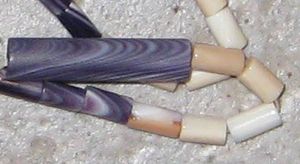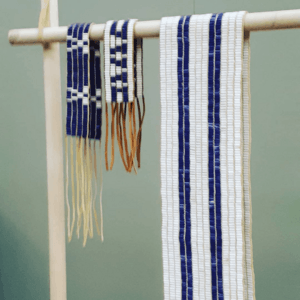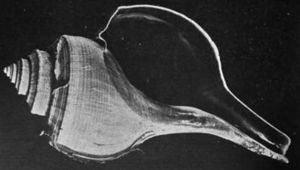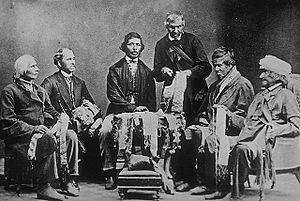Wampum facts for kids
Wampum is a special type of bead made from shells. Native American tribes in the Eastern Woodlands of North America traditionally made and used these beads. White beads come from the North Atlantic channeled whelk shell. Purple and white beads are made from the quahog, a hard-shelled clam.
People have found wampum beads in New York that date back to before 1510. Before Europeans arrived, Native Americans used wampum strings for many important things. They used them for telling stories, as gifts in ceremonies, and to remember important agreements or historical events. Famous examples include the Two Row Wampum Treaty and the Hiawatha Belt. Some tribes also used wampum as a way to trade goods. Early European colonists saw it as money and started using it for trading too. Later, colonists used their tools to make wampum much faster. This made wampum less rare and eventually less valuable as money.
Contents
What Does Wampum Mean?
The word wampum is a shorter version of wampumpeag. This word comes from the Massachusett or Narragansett languages. It means "white strings of shell beads."
Originally, wampum only referred to the white beads. These were made from the inner spiral of the channeled whelk shell. The darker, purple beads were called sewant or suckauhock. These came from the quahog clam shell. Colonists in New Netherland often used the term sewant for this currency. The Lenape name for Long Island, Sewanacky, shows its connection to the dark wampum beads.
How Wampum Was Made
Wampum beads are usually shaped like tubes. They are often about a quarter of an inch long and an eighth of an inch wide. Some old Seneca wampum belts had beads almost 2.5 inches long!
Traditionally, women artists made wampum beads. They would first shape small pieces of whelk shells into round forms. Then, they would drill a hole through them. They used wooden pump drills with quartz bits and heavy stones to make the holes. After drilling, the unfinished beads were strung together. They were then rolled on a grinding stone with water and sand until they became smooth. Finally, the beads were strung or woven onto deer hide, animal tendons, or plant fibers.
Making wampum with stone tools was very hard work. Only tribes living near the coast could easily get the shells needed. This made wampum rare and valuable, especially to European traders. When Europeans brought metal tools, it completely changed how wampum was made. By the mid-1600s, millions of beads were being produced. Dutch colonists realized how important wampum was for trade between tribes. They started making it in large workshops. One such factory in New Jersey made wampum until the early 1900s. Eventually, most wampum came from these colonial factories. This led to too much wampum being available, which lowered its value.
How Wampum Was Used
Keeping Records and Memories
Wampum belts were like a special kind of writing. Different patterns and colors of beads stood for different ideas. Anyone who understood the "wampum language" could read them, no matter what spoken language they used. These belts helped people remember important records and treaties. People could even send messages to each other using wampum.
Wampum belts also helped people remember oral traditions, which are stories and histories passed down by speaking. They were sometimes used as symbols of power or for ceremonies in Native American cultures, like among the Iroquois. For example, a chief named Tecumseh once used a wampum belt to remind people of treaties and battles from 20 years earlier.
Social Connections and Peace
Wampum strings could be given as a formal way to show friendship or cooperation between groups. They were also used as invitations to meetings.
The Iroquois used wampum as a way to show a person's authority or official role. It was also used for official business and religious ceremonies. Wampum helped to create peace between different tribes. Among the Iroquois, every chief and clan mother has a specific wampum string. This string acts like their certificate of office. When a leader steps down or passes away, their wampum string goes to the new leader. Messengers carrying important news during colonial times would show wampum to prove they had the right to deliver the message.
Iroquois warriors who were very skilled were taught how to understand the wampum belts. The Onondaga Nation, known as the Keepers of the Central Fire, were trusted with keeping all the wampum records. Wampum is still used today in ceremonies to appoint new chiefs and in Iroquois Thanksgiving ceremonies.
Wampum was also key in the tradition of "giving names." This is where the names and titles of people who had passed away were given to others. Important leaders who died were quickly replaced. A wampum bead with the deceased person's name on it would be placed on the shoulders of the new leader. The new leader could accept the name or shake it off. Accepting a name could also mean taking on the past history and duties of the person who held the name before.
Wampum helped keep Iroquois society strong by allowing names and histories to continue. It was also essential for making and renewing peace between clans and families. When representatives from different groups met, they would offer a wampum bead. This bead had symbols to remind them of the meeting's purpose or message. Wampum helped make sure these important practices continued.
Wampum as Money
When Europeans arrived in the Americas, they started using wampum as money to trade with Native American peoples in New England and New York. Wampum was even considered legal money in New England from 1637 to 1661. It continued to be used as money in New York until 1673. There, eight white wampum beads or four black wampum beads were worth one stuiver (a Dutch coin). This meant white beads had the same value as a copper coin. In New Jersey and Delaware, six white beads or three black beads were worth one penny. Since black shells were rarer, they were worth more than white ones. This led some people to dye white shells black, which made the black shells less valuable.
In 1705, Robert Beverley Jr. wrote about tribes in Virginia. He said that peak referred to white shell beads, which were worth 9 pence per yard. Wampom peak meant the more expensive dark purple shell beads, valued at 1 shilling and 6 pence (18 pence) per yard. He also mentioned another, less valuable currency called roenoke, made from cockleshells.
Wampum was briefly legal money in North Carolina in 1710. However, its use as common currency mostly ended in New York by the early 1700s.
Recent Wampum News
- The National Museum of the American Indian returned eleven wampum belts to Haudenosaunee chiefs. This happened at the Onondaga Longhouse Six Nations Reserve in New York. These belts were from the late 1700s and are very important to the Longhouse religion. They had been away from their tribes for over a century.
- The Seneca Nation of New York asked for copies of five old wampum belts. These copies were finished in 2008. Lydia Chavez (Unkechaug/Blood) made the belts using beads from the Unkechaug Indian Nation Territory on Long Island, New York.
- In 2017, a wampum belt bought in 1913 was returned to Kanesatake. It is now used in cultural and political events there.
- The Shinnecock Indian Nation has worked to protect a traditional wampum making site. It's called Ayeuonganit Wampum Ayimꝏup, which means "Here, Wampum Was Made." Part of this original site in Southampton, Long Island, has been set aside as parkland.
- The Unkechaug Nation on Long Island, New York, built a wampum factory in 1998. This factory makes both traditional and modern beads. Native artists like Ken Maracle, Elizabeth Perry, and Lydia Chavez use these beads in their traditional belts and modern jewelry. The factory has helped bring back the use of wampum in modern Native life.
- Important traditional wampum makers in recent times include Julius Cook (Sakaronkiokeweh) (1927–1999) and Ken Maracle (Haohyoh), a faith keeper of the Lower Cayuga Longhouse.
- Artists today continue to weave historical belts. They also design new belts or jewelry based on their own ideas.
See also
 In Spanish: Wampum para niños
In Spanish: Wampum para niños







